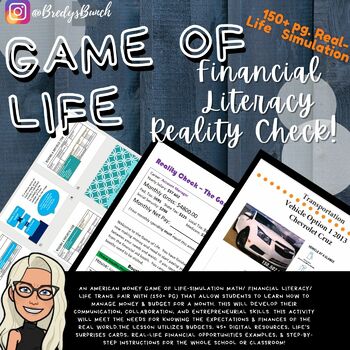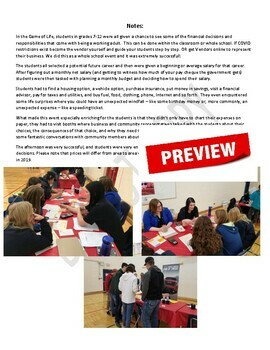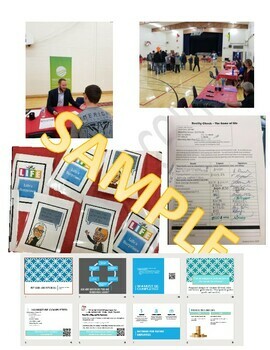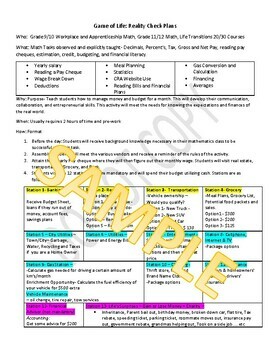Game of Life: Math & Financial Literacy Reality Check Simulation-American Money
- Zip
Description
Do you LOVE the actual Game of Life?? Ready to play it with your students? Are they prepared for the true costs of the real world?
Purpose- Teach students how to manage money and budget for a month. This will develop their communication, collaboration, and entrepreneurial skills. This activity will meet the needs for knowing the expectations and finances of the real world.
Game of Life: Reality Check Plans
Math 7/8, Grade 9/10 Workplace and Apprenticeship Math, Grade 11/12 Math, Life Transitions 20/30, and Financial Literacy Courses
Math Tasks observed and explicitly taught- Decimals, Percent, Tax, Gross and Net Pay, reading pay cheques, estimation, credit, budgeting, and financial literacy.
- Yearly salary
- Reading a Pay Cheque
- Wage Break Down
- Deductions
- Meal Planning
- Statistics
- IRS Website Use
- Reading Bills and Financial Plans
- Gas Conversion and Calculation
- Financing
- Averages
PLEASE LOOK AT VIDEO PREVIEW TO SEE WHAT'S INCLUDED! THIS IS A SIMULATION.
Activities Included:
- How-to Instructions
- 45+ Digital Resource Links for Instruction
- Station Planner
- Career Choices (40)
- Career Choices Templates to Customize
- Pay Stubs Lesson
- Need VS. Wants Lesson
- Budget Planner Sheets
- Instructions for Each of the 13 Financial Choice Stations
- 13 Station Decor and Setup Posters
- Over 50+ Choices Stations Cards for Payment options of Real Estate, Transportation, Clothing, Entertainment, Grocery, Utilities, Insurance, Gas and Vehicle Maintenance and more......
- 16 Life's Surprises Cards
- Math Game Reflection
- 23 Slide PPT
Some of items are customizable to suit your needs.
A Game of Life-Simulation Math/ Financial Literacy/ Life Trans. Fair with (150+ pg) THAT allow students to learn how to manage money & budget for a month. This will develop their communication, collaboration, and entrepreneurial skills. This activity will meet the needs for knowing the expectations & finances of the real world.
The lesson utilizes Budgets, 45+ digital resources, 40 actual careers with tax rebates to choose from, Life's Surprises cards, Real-Life Financial opportunities Examples include rentals, vehicles, grocery lists, clothing, and entertainment options & Step-By-Step instructions for the whole school or classroom!
ALL PREP is DONE for you!! Just Print and Plan your Game of Life!
In the Game of Life, students were all given a chance to see some of the financial decisions and responsibilities that come with being a working adult.
The students all selected a potential future career and then were given a beginning or average salary for that career. After figuring out a monthly net salary (and getting to witness how much of your paycheque the government gets) students were then tasked with planning a monthly budget and deciding how to spend their salary. Good for Whole School and Classroom Projects!
Students had to find a housing option, a vehicle option, purchase insurance, put money in savings, visit a financial advisor, pay for taxes and utilities, and buy fuel, food, clothing, phone, Internet, and so forth. They even encountered some life surprises where you could have an unexpected windfall – like some birthday money or, more commonly, an unexpected expense – like a speeding ticket.
What made this event, especially enriching for the students is that they didn’t only have to chart their expenses on paper, but they had to visit booths where business and community representatives talked with the students about their choices, the consequences of that choice, and why they need to make certain financial decisions.
The students had some fantastic conversations with community members about their financial choices and the ramifications of those choices.
The afternoon was very successful, and students were very engaged in the process of making some adult financial decisions.





